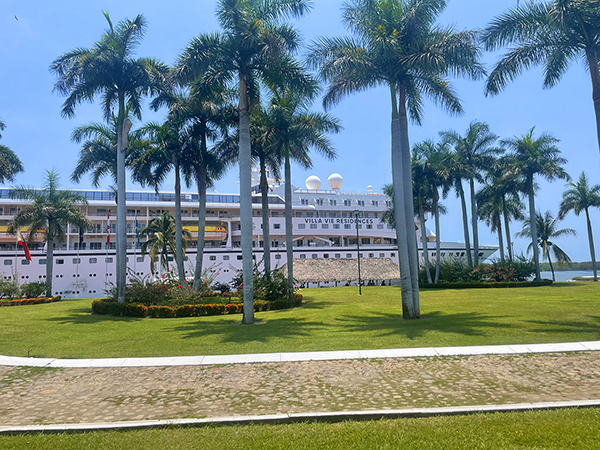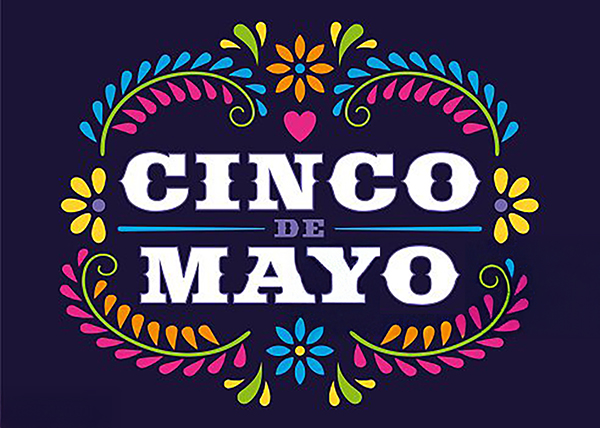

|
|
 |
 |
 |
|
May 5, 2025 Marti Eicholz As The Odyssey docks in Puerto Chiapas, Mexico, dozens of magnificent frigates fly overhead, giving us a warm greeting, along with a very hot and humid tropical climate, averaging in the mid-eighties. It is a humid 90° day with a 50% chance of showers. Puerto Chiapas, the southernmost port on Mexico’s Pacific coast, built in 1975, is the primary hub for agricultural goods, including coffee, bananas, and cacao for chocolate to be sent abroad. It consists of a small fishing village and a craft market. You can see Volcijn Tacanij, Central America’s second largest peak, 13,320 feet, from the port. We have a day to explore. The cruise terminal has two huge palapas, a traditional Mexican open-sided dwelling with a thatched roof made of dried palm leaves and branches. For a perfect combination of history, music, and chocolate, sign up for an excursion called “Izapa Ruins & Chocolate Discovery.” You journey to the ancient ruins of Izapa. From around 1500 BC the small village, Izapa, believed to be the site of the original Mayan Calendar, grew into a producer of highly valued cacao. In the central plaza there is a demonstration, showing how cacao beans are transformed into chocolate. While sampling the locally made chocolate, browse the variety of regional handicrafts, and step to the rhythm of the live traditional Chiapan dance troupe. A stop at the town’s historic church for a moment of quiet meditation. The Izapa Archaeological Site offers a glimpse into pre-Columbian Maya civilization. The Izapa ruins are not on a protected site, so it is amazing that they are as intact as they are. This site is described as “small and peaceful pre-Hispanic ruins,” an important “bridge between Olmecs and the Maya.” Archeologists theorize that Izapa began as a small village early as 1500 BC, making it as old as the oldest Olmec sites and remained occupied until 1200 AD. When the Olmecs arrived, Indigenous people lived here, but instead of ousting them the Olmecs intermarried and traded knowledge, giving rise to the Maya culture. Izapa was the template for Mayan cities. The Maya class structure perfected, language created, shape of buildings and cities designed. The “stepped” pyramids were used to reinforce the class structure; when gatherings were held, the highest classes stood or sat on the highest levels, and each level closer to, the ground held a lower class, with slaves relegated to the ground at the very base. You can see altars that held offerings to the gods as well as used for sacrifices. There is evidence of a stone aqueduct system, a stone channel which held hollowed out logs, creating “pipes” and a cistern top, shaped like a head of a reptile. We headed to the small town of Tuxtla Chico (meaning rabbit), the “birthplace” of chocolate. Four thousand years ago, Olmec turned the cacao plant into chocolate. This tiny town is where Spaniards encountered the paste made from the seeds of the cacao tree. The town square has a cacao tree displaying initial stages of fruit. Each small white pip could become fruit, but only about 20% will. Cacao beans have a coat of whitish “slime.” Usually, it is washed off before the beans get dried, not essential. It’s up to the chocolate maker’s preference. We tried sucking it off, it had an interesting citrusy taste. We got to try lightly fermented cacao juice, which tasted like guayabana fruit, a mix of strawberry and pineapple, nothing like chocolate! After de-sliming (or not), for several days the beans are dried, regularly shaken and rotated. Next the dried beans are roasted and after roasting the cacao bean’s skin is rubbed off. Now they are ready to be sold in bulk to big companies like Hershey or Lindt. Not all beans are sold. Each household in this village has their own recipe for making chocolate, but all start with grinding the roasted beans – by hand – using a curved stone mortar and stone pestle combination (a metate). The ball is shaped by hand into a log that is sliced into disc shapes. Those are used for a hot chocolate drink and baking but can be cut up and simply eaten. Divine. Women make the chocolate. Men do the tree planting and fruit harvesting. What about natural resources? The dams in Chiapas provide 55% of Mexico’s hydroelectric power. Plenty of flat land for cattle, mangoes, corn, and banana plantations that Chiquita has a weekly freighter load, leaving for the US and Canada. The area is multicultural, benefiting over the last one hundred fifty years by Japanese, Chinese, and German immigration. The regional cuisine is Chinese food. In 1890, the Mexican President and the German Chancellor collaborated, bringing four hundred fifty German families to Chiapas to develop an agriculture industry. They brought expertise, developing agriculture in the mountains, creating the now famous coffee industry. You notice the fields of corn, but look different, two crops an old and a new, harvested simultaneously. When the first planting reaches maturity, corn stalks are hacked with machetes, cobs droop, protecting them from absorbing rain. The second planting is done by hand, in between the dry stalks. The second planting matures, the two crops are harvested at the same time, a double yield, meaning four plantings each year with only two harvesting processes. You ask, “What about the dry plants?” Perfect for wrapping tamales! Today is Cinco de Mayo. No tacos, burritos, or "Corona" beer. Celebrated with Frozen Mango Margaritas and Freshly Baked Jalapeno Poppers. We sail out and celebrate Cinco de Mayo with Cinco de Mayo Sail Away Sounds. Hope you found a festive way to make this 5th of May a celebration.
|
|
Copyright © 2025 All rights reserved |